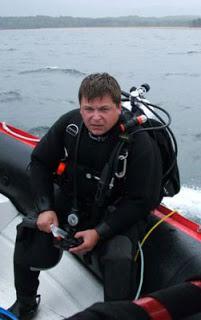
For Terry Dwyer, diving is all about shipwrecks – but not just any wreck. Exploring the same wrecks that dozens of others have viewed is not for him. He’s looking for “virgin” wrecks that no one else has seen.
“I think divers need a purpose to keep them diving,” he says. “I prefer exploring. It’s more fun, it’s an adventure and it’s motivating. I got into scuba solely to dive for wrecks. For me, it’s always been about wrecks and always about a purpose. I’m not a fan of run-of-the-mill commercial charters for known wrecks.”
Dwyer, of Halifax, remembers watching Jacques Cousteau on television when he was 14. He had Cousteau’s encyclopedia and watched his movies. At 16, he learned to scuba dive and discovered his first wreck.
He is a big advocate of diving off the coasts of Nova Scotia, where he says there are more than 10,000 shipwrecks. There are several reasons for this, both geographic and historical. When you combine a hazardous coastline with arriving ships from Europe whose crews were not only unfamiliar with its waters but also did not have the luxury or benefit of today’s technology, you have a recipe for frequent disasters.
When ships approached Nova Scotia’s rugged coastline and experienced the unpredictable winds, fog and snow, “they quite often paid a price with their ships. Nova Scotia has some of the most unpredictable weather in the North Atlantic.”
Dwyer’s all-time favourite dive site for virgin wrecks is St. Paul Island, off the northeast tip of Cape Breton in the Gulf of St. Lawrence. “There are over 350 ships wrecked on that one rock and there’s 100-foot visibility in all directions. It’s unexplored, very remote and very hostile.”
His second favourite area is the eastern shoreline of Nova Scotia, where he is currently exploring the hundreds of lost shipwrecks.
His initial book, Wreck Hunter – The Quest for Lost Shipwrecks, published in 2004, went to a second printing in 2008. It will be followed up by a new book called Wreck Hunter – Shipwreck Hunting 101, which is due out this year.
Terry has also worked in the movie industry, providing diving support services and safety divers in situations where actors are in or near the water. The films he has worked on include James Cameron’s Titanic, as well as K-19: The Widowmaker, the story of the former Soviet Union’s first nuclear ballistic submarine that had a malfunction in its nuclear reactor on its maiden North Atlantic trip.
His next big project is a “shipwreck-hunting school” in Nova Scotia, which will teach divers how to search for virgin wrecks, including the use of today’s high-tech equipment. This includes side-scan sonar, which maps the ocean floor, and a marine magnetometer, a device that measures the earth’s magnetic field. It detects metal man-made objects.
Operating out of an area that is remote and virtually unexplored, the courses will offer divers first-hand experience in locating shipwrecks. There will also be other courses offered to train divers on the use of other specialized equipment, including underwater camera systems, underwater metal detectors and Remote Operated Vehicles. In all there will be nine different training modules to choose from that will soon be posted on his website, www.wreckhunter.ca
Dwyer says training of this nature is offered nowhere else in the world. “Right now, the biggest interest is from the UK and the United States.” He has already booked his first group of shipwreck enthusiasts from the USA.
The groups will range in size from four to 10 divers, who will be “serious shipwreck people.” Dwyer says any Advanced Open-Water recreational divers can participate. “It provides a once in a lifetime opportunity.”
People can sign up for private, semi-private and group training. Costs vary greatly from about $1,000 for a person who is part of a group up to $5,000 for private or semi-private instruction or a full one-week expedition experience. The courses and expeditions involve 40 hours in a classroom and 16 to 24 hours or 40 hours on a dive boat prowling the mysterious and rugged coastline of Nova Scotia.
Dwyer says his instructors work on a part-time basis for him and range from divers who work full-time in the scuba industry, to current military instructors and people who are professional geophysical equipment operators.
Kathy Dowsett
www.kirkscubagear.com